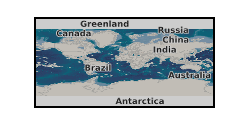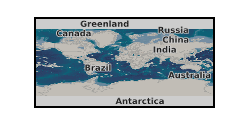csv file
Type of resources
Topics
Keywords
Contact for the resource
Provided by
Years
Formats
Representation types
Update frequencies
-

This dataset comprises 35 samples analysed for clay mineralogy from IODP Expedition 374 Site U1521 to the Ross Sea, collected on the RV JOIDES Resolution. Shipboard biostratigraphy and magnetostratigraphy suggests the samples are mainly early Miocene in age (McKay et al., 2019, Proceedings of the International Ocean Discovery Program). The uppermost samples do, however, include younger Plio-Pleistocene sediments.
-

This dataset comprises neodymium (Nd) and strontium (Sr) isotope compositions measured on 72 sediment samples, from IODP Expedition 374 Site U1521 to the Ross Sea. These were collected on the RV JOIDES Resolution. Shipboard biostratigraphy and magnetostratigraphy suggests the samples are mainly early Miocene in age (McKay et al., 2019). The uppermost samples do, however, include younger Plio-Pleistocene sediments. Neodymium and Sr isotope analyses were conducted using a multi-collector inductively coupled plasma mass spectrometer (MC-ICP-MS) and a thermal ionisation mass spectrometer (TIMS), respectively, in the MAGIC laboratories at Imperial College London. Neodymium and Sr isotopes in sediments can be compared to measurements from terrestrial rock samples, allowing the changing provenance of the sediments to be traced. This dataset therefore provides information on how erosion by Antarctica’s ice sheets bordering the Ross Sea has changed over time. Neodymium isotopes are reported in the epsilon notation, which denotes the deviation in parts per 10,000 from the present-day composition of the Chondritic Uniform Reservoir (143Nd/144Nd = 0.512638) (Jacobsen and Wasserburg, 1980).
-

This dataset comprises continuous logging of clasts >2 mm from International Ocean Discovery Program Expedition 374 Site U1521 to the Ross Sea, collected on the RV JOIDES Resolution. Shipboard biostratigraphy and magnetostratigraphy suggests the sediments are early Miocene in age (McKay et al., 2019, Proceedings of the International Ocean Discovery Program). Logged clasts are grouped by core into seven main lithological groups: igneous rocks, quartz fragments, dolerites, volcanic rocks, metamorphic rocks, sedimentary rocks and sedimentary intraclasts. A full methods description is provided at the bottom of the data file. The clast abundances can be compared to knowledge of terrestrial geology, allowing the changing provenance of the sediments to be traced.
-

This dataset comprises zircon U-Pb data on 11 samples, each containing ~90-150 individual grains. This method was applied to sediment samples from IODP Expedition 374 Site U1521 to the Ross Sea, collected on the RV JOIDES Resolution. Shipboard biostratigraphy and magnetostratigraphy suggests the samples are mainly early Miocene in age (McKay et al., 2019). The uppermost samples do, however, include younger Plio-Pleistocene sediments. Samples were measured using an Agilent 7900 laser ablation inductively-coupled plasma mass spectrometer (LA-ICP-MS) with a 25-35 µm pit diameter in the London Geochronology Centre at University College London.
-

The dataset contains three subsets: 1) W isotope data for reference materials and geological samples, 2) Pb isotope data for reference materials and geological samples and 3) Mo isotope data for reference materials and geological samples. The data was collected over a period of about two years in two different laboratories (University of Manchester and University of Bristol) using multi-collector ICPMS techniques. A description of the methods used to obtain the W and Mo isotope data can be found in Willbold et al. (2011) and Willbold et al. (2016). The determination of the Pb isotope data is detailed in Freymuth et al. (2016). The data of reference materials (standard solutions and geological reference materials) is used to assess the reproducibility and accuracy of the mass spectrometric setup at the time and used as uncertainty estimate for the geological sample data. References: Freymuth, H., Elliott, T., van Soest, M., Skora, S., 2016. Tracing subducted black shales in the Lesser Antilles arc using molybdenum isotope ratios. Geology 44, 987-990. Willbold, M., Elliott, T., Moorbath, S., 2011. The tungsten isotopic composition of the Earth's mantle before the terminal bombardment. Nature 477, 195-198. Willbold, M., Hibbert, K., Lai, Y.-J., Freymuth, H., Hin, R.C., Coath, C., Vils, F., Elliott, T., 2016. High-Precision Mass-Dependent Molybdenum Isotope Variations in Magmatic Rocks Determined by Double-Spike MC-ICP-MS. Geostandards and Geoanalytical Research 40, 389-403.
-

This dataset was generated with a novel process-based stochastic modelling approach to investigate the productivity and sustainability of groundwater abstractions in the Precambrian basement aquifer in Ghana. The statistical distribution of the generated synthetic yield data was found in very good agreement with observed yield data from the same Ghanaian aquifer. The dataset includes more than 40,000 simulated values of maximum allowable yield and corresponding transmissivity values for different realisations of aquifer heterogeneity, net recharge values, and borehole depth. Further details about the dataset and the method of generation and collection can be found in the article by Bianchi et al. (2020) "Investigating the productivity and sustainability of weathered basement aquifers in tropical Africa using numerical simulation and global sensitivity analysis" published in the Water Resources Research journal. This research was supported by the UKRI British Geological Survey NC-ODA grant NE/R000069/1 and NE/M008827/1.
 NERC Data Catalogue Service
NERC Data Catalogue Service